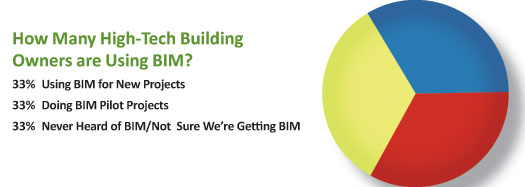SURVEY SAYS?
Three organizations — the International Facility Management Association (IFMA), International Institute for Sustainable Laboratories (I2SL), and the buildingSMART alliance (bSa) — constructed a survey with a facility management orientation to assist the industry in understanding how BIM is being used today and where it needs to go in the future.

Here are the highlights:
- 1/3 of the owners are requiring BIM for all new projects, 1/3 are doing pilot projects with BIM, and 1/3 are not sure if they are getting it right or have never heard of BIM.
- 82 percent expect BIM to impact their future and 75 percent feel they need basic knowledge of BIM and the usefulness of it for their organization.
- The 'I' in BIM is for information, which is inputted into BIM using the format standard of Construction Operations Building information exchange (COBie). Yet 50 percent of high tech building owners have not heard of COBie.
- High-tech building owners are currently using BIM 38 percent of the time post-construction for their facilities.
- Currently high-tech building owners use BIM for managing expenses; 16 percent use it for energy management and 19 percent for improving work management.
- Currently high-tech building owners use BIM for managing processes; a range of 13 percent to 27 percent use it for scheduling, space management, cost estimating, and equipment inventorying.
- 81 percent of owners would like to use BIM more to address continuous commissioning and 60 percent to 70 percent for energy monitoring.
- 20 percent of owners feel that their building information is very accurate.
- 66 percent of owners feel that either the architect or contractor should provide the final BIM deliverable, 53 percent feel that either a supervisor or the commissioning agent should verify the building information and model, and 65 percent feel that either a technician or supervisor should maintain the building information and model over time.
The results should point the industry in a direction where BIM accomplishes a broader set of objectives.
— Terence Alcorn |















